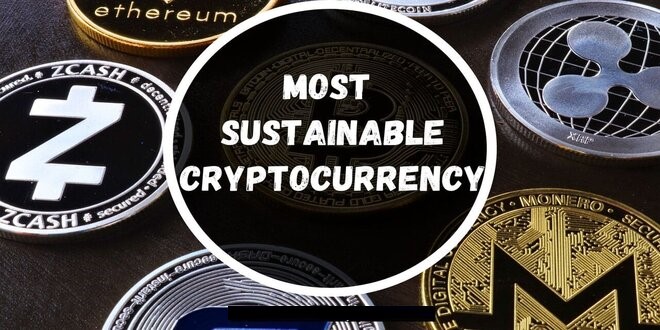Digital currency and climate issues do not have to belong in the same sentence. As a matter of fact, there are various variable alternatives to the Bitcoin giant and crypto as a whole that will benefit the ecosystem on this Earth Day, and for that, the first thing that this sector needs to do is move towards a sustainable cryptocurrency era.
The key factors that all love about this technology are its decentralization, limited inflation, self sovereignty, peer to peer payments, and also censorship resistance. It will require some fancy footwork on the blockchain’s backend to make this currency low on crypto carbon footprints. You may wonder is blockchain environmentally friendly. This article will help you to find the answer.
Sustainable Cryptocurrency: A Step Forward
The struggle to curtail the impact of digital currency on the ecosystem is nothing new and every year there are new regulations that are in favor of green energy. But is it possible to also bring in green energy in crypto?
Can there be complete green crypto mining? Is there a way where we can make clean, green, and sustainable cryptocurrency? Let us answer all these questions as we explore the sustainable future of digital currencies.
Crypto And The Environment
Over 15,000 digital currencies are presently existing across the globe and there is a huge number of uses of the PoW (Proof of Work) consensus mechanism. This implies a group of cryptographic proof where a certain portion of computational power is proven to have been expended. As a part of the consensus mechanism, it is employed for preventing fraud, validating transactions, and mining new Bitcoins. It is used by digital currencies Ethereum, Bitcoin, Dash, and Litecoin.
The mining of digital currencies via PoW was designed to be energy intensive and thus safe security branches but this is not without any drawbacks. Because of the dependence on high amounts of energy, mining is now responsible for 0.6% of global electricity consumption.
Mining itself is not an environmental hazard as computers can utilize power from any source. However, fossil fuels are responsible for nearly 80% of the global energy supply and hence power the majority of mining activities.
Apart from the emission of carbon from fossil fuels, the waste that has been generated each year by miners raises issues. As anticipated 30.7 kilotons of e-waste are generated from BTC mining alone and the amount continues to evolve with increased adoption of the digital currency. Several environmentalists look at mining as a climate threat and clamor for rules and regulations annually. There is however a bigger movement towards sustainable digital currencies.
Steps To Make Sustainable Cryptocurrency
With BTC labeled the ‘dirty currency’ and many currencies despised for their alarming carbon footprints, a chief shift is needed in the industry. Below are some ways to create a sustainable cryptocurrency industry:
Unlike the PoW (Proof of Work) consensus mechanism created to be energy-intensive, many alternatives are far more effective.
By changing to mechanisms that require less energy, the digital currency space will release fewer greenhouse gasses thus changing into more sustainable and joining the fight against climate alterations. Some energy-efficient consensus algorithms are:
Proof of Stake
Solicited as the second most employed consensus algorithm, PoS (proof of stake) is receiving ground. This mechanism includes the allocation of duty in proportion to the number of tokens held or owned. It does not need specialized equipment and utilizes 99.9 percent less energy. Even though considered less safe in comparison to PoW, it is far more sustainable. It is presently adopted by blockchains like Cardano, Polkadot, and EOSIO.
Proof of Capacity
This authentication system uses spare space on a hard drive of the device to store solutions to digital currency hashing issues. It is a two-step protocol including mining and plotting. Even though not widely accepted, it is reportedly 30x more effective than the ASIC Bitcoin mining rig. Blockchains that operate on proof of capacity involve Burst, Chia, Storj, and SpaceMint.
Proof of History
Developed by the Solana project, this mechanism encodes the passage of time itself cryptographically to attain consensus without expending many resources. Humans are not associated with its validation process, making it various times quicker than other algorithms. Its energy consumption each transaction is negligible as opposed to the 707KWh used for BTC.
Proof of Elapsed Time
In this consensus algorithm, every node in the blockchain network develops a random wait time and goes to sleep for that prominent duration. The one with the shortest wait time then creates a new block to the blockchain, transmitting the required data to the whole peer network. It is similar to the Proof of Work (PoW) mechanism but more effective because the processor of the miner goes to sleep. It is used primarily in permissioned blockchains such as Hyperledger Sawtooth.
Top 10 Sustainable Cryptocurrency To Invest This Earth Day
By using any of these options, the sector consumes at least 50 percent less energy, slashes e-waste generated, decreases carbon footprints, and becomes more sustainable. With that, let us have a look at the 10 best sustainable cryptocurrency that operate on these mechanisms.
SolarCoin (SLR)
This is the first eco-friendly cryptocurrency 2022. SolarCoin is decentralized, global, and independent of any government. You can trade and spend SolarCoin just like other digital currencies, but the key variation is that the platform tries to incentivize real-world environmental action: verifiably produced solar energy.
Powerledger (POWR)
POWR was an Ether token situated in 2016/17 that boosts the Powerledger platform. This crypto debuted on Coinbase in November last year, with the price of the token increasing rapidly even while most digital currencies fell in a market-wide crash. This surely holds the second position in this eco friendly cryptocurrency list.
Cardano (ADA)
Cardano was created by the co-founder of Ethereum, Charles Hoskinson, and was tested by scientists and academics as the first peer-reviewed blockchain in the world. It operates mainly as a digital currency but can also be utilized for DApps, digital contracts, and other purposes. Compared to the 7 transactions of Bitcoin a second, Cardano can attain 1000 per second.
Stellar (XLM)
The Stellar network was launched in 2014 (forking off from Ripple) with the aim of bridging the gap between digital currencies and traditional financial institutions. Stellar does not charge individuals or institutions for using the network and is increasingly seen as a serious alternative to PayPal as it allows easier, faster, and more cost-effective cross-border and cross-asset transactions. This is said to be the most energy-efficient cryptocurrency.
Nano (NANO)
Nano is fast, free, and uses considerably less energy in comparison to BTC and many other digital currencies. This is one of the best low energy cryptocurrency. It has been around since the end of 2015 and has a comparatively small carbon footprint even now. This sustainable cryptocurrency is also scalable and lightweight as it does not depend on mining.
IOTA (MIOTA)
As a digital currency, IOTA has not proven as fluctuating in terms of value as many other tokens. While good news for those investors who are looking for more stability in the market and broader financial sustainability, this has proven disappointing for those investors searching for the same pay-off as with early investments in Ethereum, Bitcoin, or other altcoins.
EOSIO (EOS)
EOSIO is a public blockchain accepted by developers as it is simple to set up and write applications in various programming languages, costs nothing, and is highly scalable.
Tron (TRX)
Established in Singapore, TRON is a non-profit organization and also a public blockchain supporting almost each programming language. The peer-to-peer platform enables creators to share applications directly on the blockchain, making the complete process more energy efficient.
Signum (SIGNA)
In June last year, Burstcoin officially changed its name to Signum, under the ticker SIGNA. The original Burstcoin is presently essentially void because of a hard fork following a prominent price reduction after the crypto was delisted from Poloniex in May 2019.
Holochain Or HoloTokens (HOT)
2021 was an important year for Holo. The crypto token price increased to nearly 53 times in comparison to the 2018 ICO price and the entity offered its Elemental Chat platform a test run, with a public launch expected shortly.
Wrapping Up
The change to clean and green energy might not be convenient but is definitely required and daily steps to this focus must be taken. Incentives are being offered as the world begins a forward motion to renewable power. It is important to join this movement of sustainable cryptocurrency and contribute to the sustainable future of digital currencies.
- Top 7 Best VPN For China: Tested And Working - 19/10/2023
- 7 Best VPN For Canada: How To Dodge Five-Eye Security - 16/10/2023
- Top 5 Best VPN For UAE & Dubai That Accepts Crypto - 15/10/2023
 Crypto Venture News One stop Crypto Track Down
Crypto Venture News One stop Crypto Track Down 






